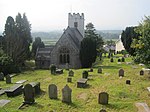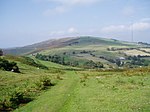Bodfari railway station
1869 establishments in WalesBodfariDisused railway stations in DenbighshireFormer London and North Western Railway stationsPages with no open date in Infobox station ... and 3 more
Railway stations in Great Britain closed in 1962Railway stations in Great Britain opened in 1869Use British English from December 2016

Bodfari railway station was opened on 6 September 1869 by the Mold and Denbigh Junction Railway. Following the Railways Act 1921 the line became part of the LMS. The station was located to the west of the road bridge on the A541 close to the village. Station buildings were on the Chester bound platform and there was a shelter on the Denbigh platform. The station closed in April 1962.The station site today is a private residence but the station building is still standing.
Excerpt from the Wikipedia article Bodfari railway station (License: CC BY-SA 3.0, Authors, Images).Bodfari railway station
A541,
Geographical coordinates (GPS) Address Nearby Places Show on map
Geographical coordinates (GPS)
| Latitude | Longitude |
|---|---|
| N 53.219 ° | E -3.3574 ° |
Address
Bodfari
A541
LL16 4DJ , Bodfari
Wales, United Kingdom
Open on Google Maps








